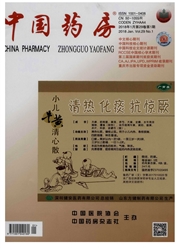

 中文摘要:
中文摘要:
目的:观察人I型磷脂酶A2(PLA2)的N末端衍生多肽PLA2N1-15对不同细菌的体外杀菌活性。方法:以人I型PLA2N末端的15个氨基酸残基为模板,合成多肽PLA2N1-15.采用琼脂铺板计数法,记录并计算不同质量浓度(1000、250、62.5、15.625μg/ml)的PLA2N1-15对革兰阳性(G^+)菌(金黄色葡萄球菌、粪肠球菌、枯草芽孢杆菌)和革兰阴性(G^-)菌(大肠埃希菌、铜绿假单胞菌、变形杆菌)的杀菌率。结果:15.625、62.5、250、1000gg/ml的PLA2N1-15对G^+菌的杀菌率分别为10%~19%、36.55%~89.73%、83%~100%、96%~100%,对G^-菌的杀菌率分别为8.86%~22.63%、21.61%~40.55%、40%~83%、87%~93%。结论:高浓度PLA2N1-15对G^+和G^-均具有较强的杀菌活性,特别是对G^+。
 英文摘要:
英文摘要:
OBJECTIVE: To observe the bactericidal activity of the polypeptide derived from N-terminal sequence of human type I phospholipase A2 (PLA1N1-15) in vitro. METHODS: PLA2N1-15 was synthesized according to 15 amino acid sequence from N-terminal of human type I PLA2. The sterilizing rate of different concentrations of PLA2N1-15 (1 000, 250, 62.5, 15.625 μg/ml) to Gram-positive bacteria (including Staphylococcus aureus, Enterococcus faecalis, Bacillus subtilis) and Gram-negative bacteria (including Escherichia coli, Pseudomonas aeruginosa, Proteusbacillus vulgaris) were calculated and recorded by agar plate colony counting. RESULTS: The sterilizing rates of 15.625, 62.5, 250 and 1 000 μg/ml PLA2N1-15 to Gram-positive bacteria were 10%- 19%, 36.55%-89.73%, 83%-100% and 96%-100%, respectively; those to Gram-negative bacteria were 8.86%-22.63%, 21.61%- 40.55 %, 40 % -83 % and 87 %-93 %, respectively. CONCLUSIONS: High concentration of PLA2N1-15 possesses strong bactericidal activity to Gram-positive bacteria and Gram-negative bacteria, particular to Gram-positive bacteria.
 同期刊论文项目
同期刊论文项目
 同项目期刊论文
同项目期刊论文
 期刊信息
期刊信息
